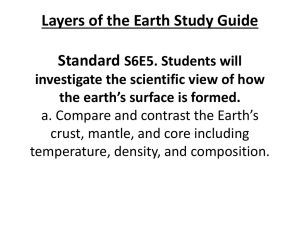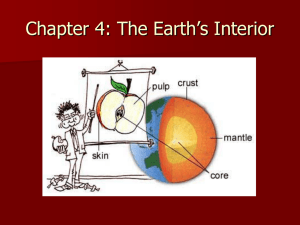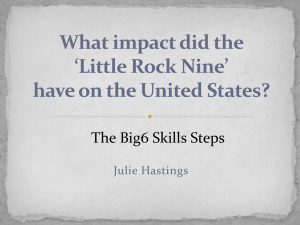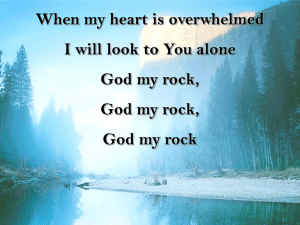Earth`s Changing Crust
advertisement
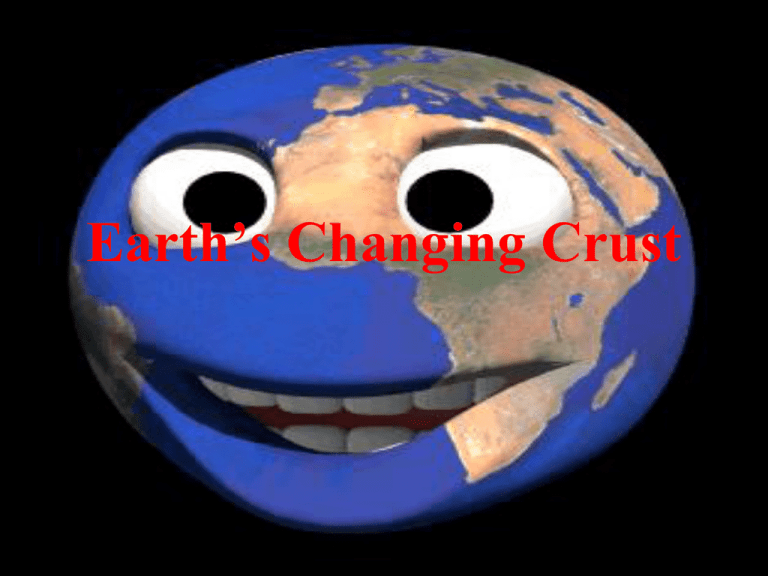
Earth’s Changing Crust Vocabulary fault Cracks in the crust Geologists Scientists who study the Earth Magma Hot molten rock deep below the Earth’s surface Lava Magma that reaches the Earth’s surface Weathering Breaking down rocks into smaller pieces Erosion The picking up and carrying away of pieces of rock Deposition The dropping off of bits of eroded rock Meteorite Rocks from space that strike a surface What Makes the Crust Move • http://videos.howstuffworks.com/howstuffw orks/236-how-earthquakes-work-video.htm Forces on and Under Earth Shape Its Surface • The Earth’s crust is constantly moving. • Earthquakes are related to cracks in the crust called faults. • San Andreas Fault • During an earthquake the crust on either side, or both sides of a fault is in motion. • Vibrations travel through the crust. The farther away people are from the earthquake, the harder it is to feel the vibrations. • Seismographs record the motion at locations all around the crust. • Most of the time the crust moves VERY slowly and people only notice when there is a visible change. • To measure crust movement, surveyors measure elevation (how high a place is above sea level). • Geologists place sensitive devices all along faults. They hope that records of tiny movements can be used to predict an earthquake. Plate Tectonics • The crust is the Earth’s hard surface. – It is very thin. – About one-thousandth of the Earth’s thickness Plate Tectonics • The Mantle – Located under the crust – Earth’s thickest layer – Rock material here is solid, however it can flow like a liquid. (Like putty does when you squeeze it.) – Rock material is always in motion like heated water in a pot. – It rises and pushes against the bottom of the crust. This causes it to break into pieces, or plates. – Earthquakes and slow motions of the crust result from moving plates. Plate Tectonics • Earth’s Core – Located below the mantle – Two parts • A liquid Outer Core • A solid Inner Core What Forces Act On The Crust • http://videos.howstuffworks.com/howstuffw orks/236-how-earthquakes-work-video.htm What Forces Act on the Crust? • As plates of the crust move they can collide, pull away from each other, or slide past each other. • These movements cause 3 kinds of force to act on the crust. – 1. Tension – stretches or pulls apart the crust – 2. Compression – squeezes or pushes together the crust – 3. Shear – twists, tears, or pushes one part of the crust past another • Forces in the crust cause a fault to form and movement is caused along the faults. • Compression can crumple rock layers into wavy folds. When two pieces of crust crash together, mountains are formed. • Mountains made of folded and crumpled layers are called fold mountains (Appalachians, Alps, and Himalayas) Volcanoes • Tension and shear can also build up the crust. Mountains can be formed as the crust is pulled apart. • Hot molten rock deep below the Earth’s surface (magma) rises upward. If this reaches the surface it may flow out as lava. • Lava flows out when a volcano erupts. • Volcanoes can also form islands. Check This Out! • Hawaii Big Island Volcano eruption Fault-block Mountains • Tension and shear can cause great blocks of crust to break apart cleanly and move along faults. This forms fault-block mountains. What Other Forces Shape the Earth’s Surface? • While movements of the crust are building up the Earth’s surface, other forces are breaking it down. – Weathering – Erosion Weathering • The breaking down of the materials of Earth’s crust into smaller pieces. • Occurs when the crust is exposed to water, air, and changes in temperature. • http://www.uky.edu/AS/Geology/howell/go odies/elearning/module07swf.swf How Does Weathering Occur? • Water can dissolve some minerals right out of the crust. • Moving water can make pieces of rock bang into each other. – Small chips break off of the surface of the rock causing the rock to get smaller and rounder. – Churning waters of a stream can wear down big pieces of rock into small, rounded pebbles. How Does Weathering Occur? • The wind blows sand and other bits of broken bits of rock over Earth’s surface. These particles also wear away rock. • When temperatures are low enough, water freezes and expands. The force of expanding water is so great that it can split rock apart. • Changes in temperature can also cause rock to expand and contract. When parts of a rock expand or contract more than others it can cause the rock to break apart. Chemical Weathering • Air contains gases that react chemically to form new substances. • Oxygen in air reacts with iron to form rust. • Carbon dioxide and sulfur dioxide in air react with rain to form acids. • These acids eat away at limestone rock. Erosion • The carrying away of pieces of weathered rock by gravity, water, wind, and ice. • Erosion can carry away a boulder, hill, or even a mountain range piece by piece. • Water is the greatest agent. Each drop of water falling from the sky erodes the land. • Water moving downhill picks up pieces of rock and carries them downhill. The faster the water the bigger the pieces of rock. What Does This All Look Like? • HowStuffWorks Videos "Basics of Geology: Erosion and Weathering" How Can Wind Erode Rock? • Wind does not exert as hard a push as water moving. • Wind mostly erodes pieces of rock that are the size of sand particles or smaller. How Can Ice Erode Rock? • Ice causes lots of erosion. • When ice of a glacier freezes onto rock and then the glacier moves downhill, the rock is torn right out of the ground. It can carry chunks of ice bigger than your house with ease. • Glaciers also wear away the land. Rocks of all sizes become frozen to the bottom of the glacier. As the glacier moves the rock beneath it is scratched and worn down. Ice and Sand Experiment • Describe in detail what you observed during the experiment. Where Do Eroded Rocks Go? • They are dropped to the bottom of the stream, lake, or ocean when the water stops moving. (DEPOSITION) • Deposition takes place when glaciers melt and wind stops blowing. • Layer by layer, pile after pile, bits and pieces of rock deposited by the water, wind, and ice build up on Earth’s surface. • Deposition eventually fills up depressions in the Earth’s surface. It can build up land along shore lines. What Forces Shape The Moon’s Surface? • Without air and water, there can be very little weathering or erosion. • The only weathering and erosion is due to the impact of rocks from space hitting the Moon’s surface (meteorites). • Some craters formed by meteorites are big enough to be seem from Earth. • Earth’s atmosphere protects its surface from such impacts. Rocks from space “burn up” as they pass through our atmosphere.



